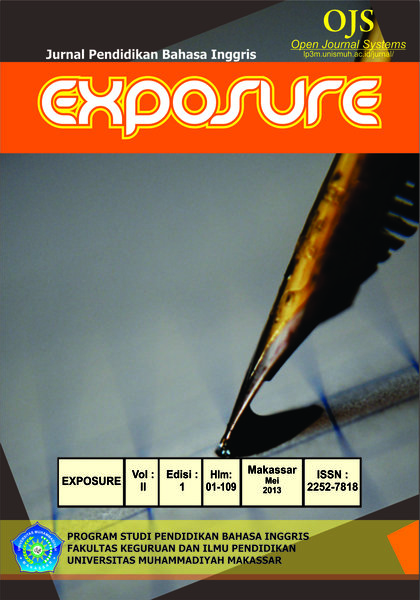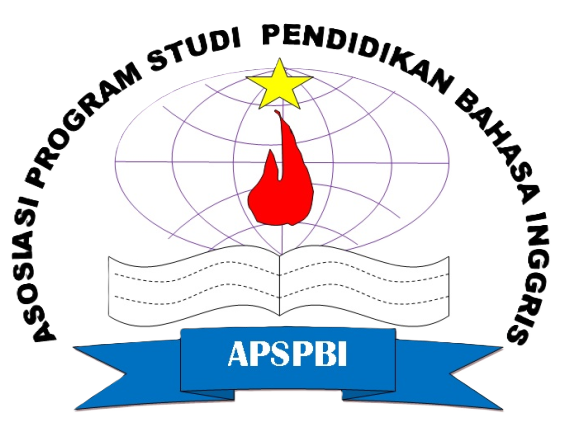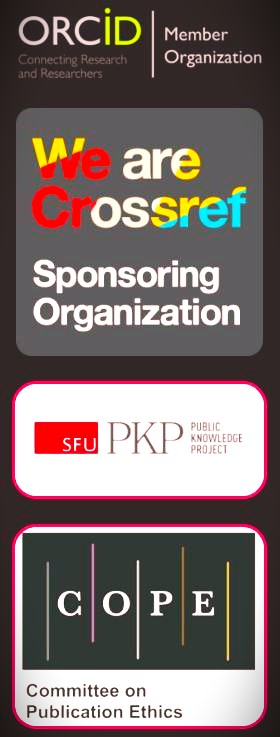IMPROVING THE STUDENTS’ SPEAKING ABILITY THROUGH PARTICIPATION POINT SYSTEM (PPS) METHOD
DOI: https://doi.org/10.26618/exposure.v2i1.779
Abstract
This research was aimed at finding out the improvement of students’ speaking accuracy and fluency through Participation Point System (PPS) Method in teaching speaking. The research method used was class action research design consisting of 4 stages, namely planning, action observation, and reflection. It had 2 cycles. The research was implemented by the Tenth-grade students of SMA PGRI Sungguminasa 2011/2012. The researcher took 26 students as the subject of the research. The researcher taught speaking English using PPS Method. The data were gathered after scoring the students’ speaking ability on both accuracy (vocabulary and grammar) and fluency (smoothness) through diagnostic test and test of the cycle I and II. The research findings showed that the mean score of the students’ speaking diagnostic test was 3.7 as categorized poor (low ability) while the mean score of the students’ speaking test in cycle I was 5.2. It had a significant progress but the result still did not reach the determined standard score 6.5, so the research has proceeded to the cycle II that the researcher gained the mean score 7 as categorized well. It showed that the latest progress in the cycle II had reached beyond the determined standard score and there was a significant improvement on the tenth-grade students’ speaking ability on both accuracy (vocabulary and grammar) and fluency (smoothness) in the English teaching using Participation Point System Method at SMA PGRI Sungguminasa 2011/2012.
Keywords: Improving, Speaking, Participation, Point, System.
References
Brown, David. (2006). Conversation Means Talking: A Case Study in Encouraging Participation in a Thai University English Conversation Class. Teachers’ Articles vol. XI, No 1, January 2006. Retrieved from http:///www.asian-efl-journal.com/pta_january_06_db.php on August 7, 2011
Brown, G. and Yule, G. (1989). Teaching the Spoken Language: Approach Based on the Analysis of Conversational English. Australia: Cambridge University Press.
Brown, H.D. (2001). Teaching by Principles. Longman. New York: Longman
Bryne, Donn. (1987). Teaching Oral English. New Edition. New York: Longman
Chaney. A.L. (1998). Teaching Oral Communication in Grades K-8. Boston: Allyn and Bacon.
Crystal, D. (1997). The Cambridge Encyclopedia of Language. Cambridge: Cambridge University Press.
Fisher, R. (1990). Teaching Children to Think. Basil Blackwel
Gandner, R & Lamber, W. (1972). Attitudes and Motivation in Second Language Learning. Rowley, Massachusetts: Newbury House.
Hadley, G (1997). Encouraging Oral Communication in the EFL Classroom. Paper Presented at Niigata University General Education and
Language Research Group. Niigata City. Japan. Retrieved from www.nuis.ac.jp/~hadley/publications/partpoints/participation.htm on August 7, 2011
Hadley, G.(2001). The CEP Report: An International Curriculum for the 21st Century. Department of Information Culture, Niigata University of International and Information Studies. Retrieved from http://www.nuis.ac.jp/~hadley/main/cepreports/CEP2001.htm on August 7, 2011
Hancock, Mark & Sylvie, Donna. (2003). English Pronunciation and Use. New York: Cambridge University Press.
Harmer, J. (2001). The practice of English Language Teaching. Malaysia: Longman.
Harmer, J (2003). The Practice of English Language Teaching: Longman Handbooks for Language Teaching. USA: Longman Inc., 2003
Harmer, J. (2007). How to Teach English. Essex: Pearson Education Limited
Heaton. J. B. (1988). Writing English Language Tests. New York: Longman Inc New York Press.
Huebner, T. (1960). Audio-Visual Techniques in Foreign Language. New York: Cambridge University Press, 1960.
Jeffrey, D. M. (2003) A Participation Points System to Help Passive Students Communicate. CELE Journal 12, final, David J., FE Participation Points.pdf. Retrieved at www. asia-u.ac.jp/053%20CELE%20Jrnl%2.htm on August 7, 2011
Jefferey, D.M. (2003). Participation Point System to Encourage Classroom Communication. The Internet TESL Journals vol. IX. No 8, August 2003. Retrieved at http://iteslj.org/techniques/Jeffrey-PointSystem.html on August 7, 2011
Jeffrey, D.M. (2005). A Motivational Participation Points System. Retrieved at http://jalt-publications.org/archieve/proceedings/2004/E20.pdf on August 7, 2011
Jones, R. (1989). Speaking and Listening. London: The Bath Press.
McCarthy, Michel. (1990). Vocabulary. New York: Oxford University Press.
Oxford Advance Dictionary. (1995). Oxford: Oxford University.
Reece and Walker (1997). Teaching, Training, and Learning. Durham: Business Education Publisher.
Revell, J. (1989) Teaching Technique for Commutative English. London Macmillan: Pres Ltd.
Simon and Schuster (1978). New Perspective on Grammar Teaching in Second Language Classrooms. New Jersey: Lawrence Erlbaum Inc.
Downloads
Published
How to Cite
Issue
Section
License
Authors who publish with this journal agree to the following terms:
In order to assure the highest standards for published articles, a peer review policy is applied. In pursue of the compliance with academic standards, all parties involved in the publishing process (the authors, the editors and the editorial board and the reviewers) agree to meet the responsibilities stated below in accordance to the Journal publication ethics and malpractice statement.
Duties of Authors:
- The author(s) warrant that the submitted article is an original work, which has not been previously published, and that they have obtained an agreement from any co-author(s) prior to the manuscript’s submission;
- The author(s) should not submit articles describing essentially the same research to more than one journal;
- The authors(s) make certain that the manuscript meets the terms of the Manuscript Submission Guideline regarding appropriate academic citation and that no copyright infringement occurs;
- The authors(s) should inform the editors about any conflict of interests and report any errors they subsequently, discover in their manuscript.
Duties of Editors and the Editorial Board:
- The editors, together with the editorial board, are responsible for deciding upon the publication or rejection of the submitted manuscripts based only on their originality, significance, and relevance to the domains of the journal;
- The editors evaluate the manuscripts compliance with academic criteria, the domains of the journal and the guidelines;
- The editors must at all times respect the confidentiality of any information pertaining to the submitted manuscripts;
- The editors assign the review of each manuscript to two reviewers chosen according to their domains of expertise. The editors must take into account any conflict of interest reported by the authors and the reviewers.
- The editors must ensure that the comments and recommendations of the reviewers are sent to the author(s) in due time and that the manuscripts are returned to the editors, who take the final decision to publish them or not.
Authors are permitted and encouraged to post online a pre-publication manuscript (but not the Publisher’s final formatted PDF version of the Work) in institutional repositories or on their Websites prior to and during the submission process, as it can lead to productive exchanges, as well as earlier and greater citation of published work (see The Effect of Open Access). Any such posting made before acceptance and publication of the Work shall be updated upon publication to include a reference to the Publisher-assigned DOI (Digital Object Identifier) and a link to the online abstract for the final published Work in the Journal.














